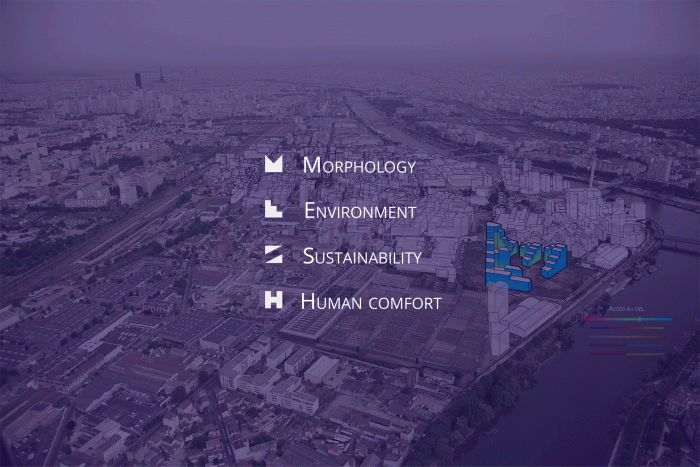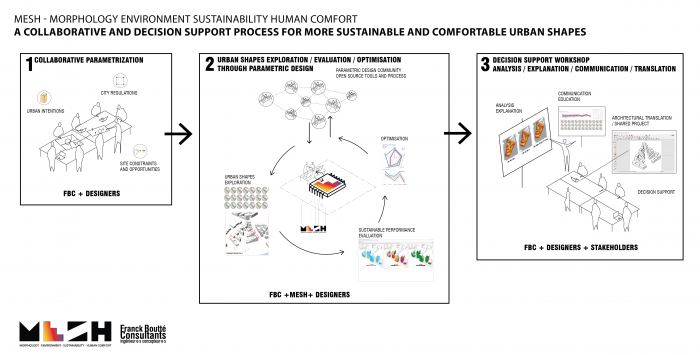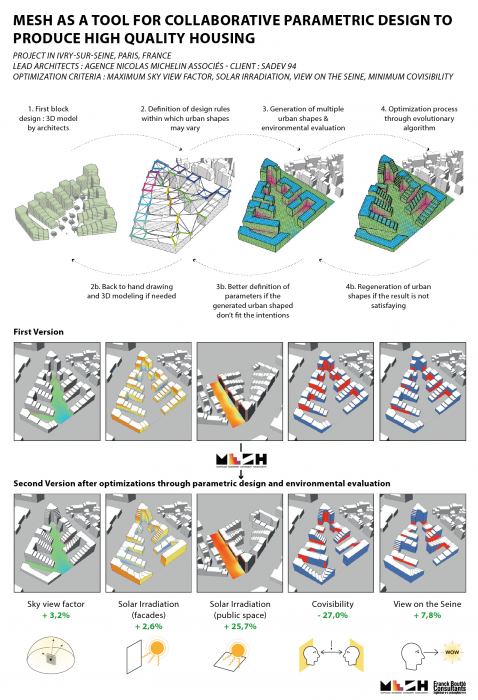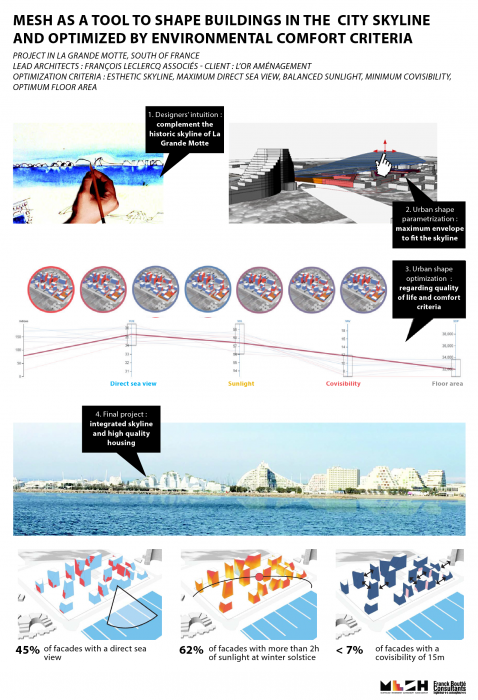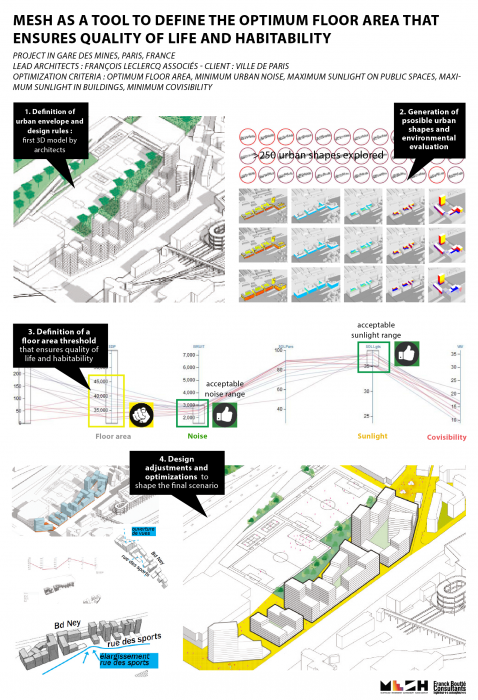I. SUMMARY INFORMATION
Project
269352
Status
Submitted
Award category
Techniques, materials and processes for construction and design
You want to submit
NEW EUROPEAN BAUHAUS AWARDS : existing completed examples
Project title
MESH
Full project title
MESH | Morphology, Environment, Sustainability, Human Comfort
Description
The MESH project combines parametric design tools in an algorithm capable to assess, compare and improve urban forms, optimising them to match performance indicators such as energy consumption and human comfort. It tackles the complexity of environmental, through a multiscale and holistic approach of urban morphologies. The MESH project is extremely flexible to circumstantial operational needs, promoting the adaptation of cities to mitigate and adapt to climate change
Where was your project implemented in the EU?
France
Occitanie
Avenue Robert Fages
43.559394
4.076241
La Grande Motte
34280
When was your project implemented?
Has your project benefited from EU programmes or funds?
No
Which programme(s) or fund(s)? Provide the name of the programme(s)/fund(s), the strand/action line as relevant and the year.
II. DESCRIPTION OF THE PROJECT
Please provide a summary of your project
MESH is a flexible, evolutive tool for developers, local authorities, architects and urbanists, capable to adapt morphological hypotheses on urban planning through an iterative design process, guided by environmental analysis.
MESH stands at the interface between research and design, using a multiscale and holistic approach. Its utility in an operational framework relies simultaneously on the accuracy of its assessments, on its responsiveness and on its capacity to adapt to circumstantial operational needs, allowing to conceive better cities to mitigate climatic change through an involvement in the different phases of the design process, especially the first ones.
MESH assesses, compares, and improves urban forms, optimising them to match performance indicators such as energy consumption and human comfort. The complexity of urban morphologies is interrogated through the prism of environmental quality. The project is based on the observation that health and environmental issues are often considered too late, while morphology can be a determining factor to respond to these issues in advance. In addition to being a major lever to environmental quality, morphology can provide sensible improvements at a cost nearing zero, contrarily to better construction materials for example.
Thanks to a careful identification and development of appropriate environmental indicators, MESH can realise a comparative assessment of the projects for different scales, suggesting possible improvements by the selection of the generated morphologies that enhance more relevant criteria.
With MESH, the innovation is not self-referential, but it concerns the process of project development, allowing its optimisation. The quality of the final solution is the result of MESH's own approach to operational projects, which is based on a combination of artificial and human intelligence.
Please give information about the key objectives of your project in terms of sustainability and how these have been met
Sustainability is primary ambition of the MESH project, which improves environmental awareness into the development of urban projects at an early stage of the architectural sketches.
In MESH, quality assessment depends on a set of quantitative indicators, drawn from a state-of-the-art based on the cross-analysis of three inputs: geographical and climatic features, typo-morphology of the built fabric, and human comfort.
MESH goes beyond the analytical approach to undertake a systemic exploration of sustainability in a transversal way, treating the complex interactions with multicriteria calculation. The paradigm of multi-criterion decision, which operates through performance indicators, is therefore used as an alternative approach for optimising a global function. This system of indicators is the base for the assessment of genetic algorithms: the relative quantification of the environmental gains (energy, thermal, visual etc.) to establish the intrinsic performance of an urban form.
Beyond the tool, MESH promotes a new collaborative design process, to better understand environmental issues and the impact that the morphology may have on them.
Indeed, the developed methodology combines calculation capabilities with visual communication, allowing designers and local authorities to increase their knowledge of environment-health-wellness indicators, while integrating their own formal guidelines in the genetic algorithm’s morphological exploration.
For these reasons, MESH is a powerful decision-making tool to guide urban developers towards the best possible choices in terms of cities’ environmental performance, to accelerate the climatic awareness and the operational translation of strategic sustainable development objectives on architectural geometries.
Please give information about the key objectives of your project in terms of aesthetics and quality of experience beyond functionality and how these have been met
The MESH algorithm develops essential guidelines to the aesthetics of an architectural project, as it optimises the urban morphology to improve environmental benefits, considering criteria such as the beauty of the site and the well-being of the inhabitants. By defining the basic geometry of urban settlements, MESH brings an important contribution to the aesthetics of the future construction.
MESH is part of a collaborative design process, providing the morphological basis to engage the creativity of urban planners, architects and landscapers to realise the finished project. The parametric generation of an urban morphology requires to establish certain selected characteristics to evolve. These parameters are chosen to translate designers’ intentions in rules to be respected by the form exploration.
Moreover, MESH interest goes beyond the single building, as it addresses aesthetic in a broader vision that includes the surrounding environment. In fact, morphological optimisation also considers the qualities of the views, including those of the surrounding buildings, seeking to enhance and the existing landscape quality while preventing its obstruction. An example of application can be found in the "La Grande Motte" project, where the MESH algorithm helped the integration in the existing skyline.
In this sense, the MESH project has a double approach to the aesthetics of the built space, defining the forms of new constructions which, at the same time, enhance the existing elements of interest. Thus, MESH's contribution to aesthetics is to find beauty in the relationships between the elements involved, which affects the configuration of the specific project.
Finally, recalling MESH's objective of conceiving spaces that are pleasant to live in thanks to parameters such as thermal comfort, the algorithm represents a methodology of ambience design, that reconciles sustainability and functionality with the quality of spaces and of the experience that they can provide.
Please give information about the key objectives of your project in terms of inclusion and how these have been met
The MESH project leads to an urban vision that enhances population inclusion, as it uses the optimisation of genetic algorithms to identify the morphology that will implement the quality of urban spaces as much as possible. This approach is applied to both built and outdoor spaces, creating comfortable zones that offer a high-quality experience, creating areas where it is pleasant to stay. The creation of comfortable zones that could mitigate mitigating extreme climatic conditions encourages the conviviality of people in urban spaces, including the most sensitive ones, resulting in an implementation of the resilience of cities towards climate change and in the reducing of building’s energy consumption to reduce urban heat island effects.
Furthermore, Mesh is inclusive in other ways.
From a methodological point of view, it is inclusive towards existing methodologies, as it brings together different tools in a single platform, in an easy and ready to use process that can be shared with all people involved in the city planning and use – developers, authorities, inhabitants. It aims to include everyone in the making process for more sustainable cities and buildings. From an environmental and design point of view, it includes sustainability and quality criteria for the outdoor environment at the earlies stages of the project; from a research and innovation point of view, it is open for new developments, allowing the addiction of new disciplines. According to the last point, the MESH 2C project is currently under development, to add new scientific analysis to the initial algorithm, such as perceived temperature, urban heat islands and vegetation effects.
Please give information on the results/impacts achieved by your project in relation to the category you apply for
The fundamental impact of MESH algorithm is to allow the inclusion of environmental sustainability and microclimatic quality in the early stages of the design process, to define the geometry that intrinsically has the best potential in terms of reducing energy consumption and protecting human comfort, therefore contributing to the mitigation of global warming and to the implementation of the resilience of cities, for population’s protection against extreme climatic phenomena. Currently, since the use of various calculation software to calculate different criteria requires long computational times, these analyses are carried out mainly in retrospect, when the possibilities of adaptability of a project are limited. MESH solves these problems by automating the entire process, directly involving numerous tools for the rapid calculation of environmental quality indicators in a single platform. By gaining time and analysing problems at an early stage of the project, MESH helps architects, urban planners and landscapers to address complex environmental sustainability issues earlier in the construction process.
Other impacts of MESH regards costs (economical savings compared to a morphological modification a-posteriori to integrate environmental factors), innovation (by encouraging the application of research tools on operational projects) and communication of project benefits (through simple graphical and numerical comparisons).
MESH has been applied in on a wide range of operational projects, including the "Ballade project in la Grande Motte", “Gare des Mines in Paris”, “4G plot in Ivry-sur-Seine"... making it possible to address the initial vision proposed by the architects by identifying morphological variations capable to guarantee an intrinsically higher environmental potential, verified through the objectivity of numerical simulations.
Please explain the way citizens benefiting from or affected by the project and civil society have been involved in the project and what has been the impact of this involvement on the project
MESH is extremely flexible and potentially adaptable to any project. By emphasising environmental quality criteria in the design process, MESH makes it possible to improve the comfort of spaces through careful morphological optimisation, in favour of all categories of users in the population.
In addition, MESH is part of a co-conception process, whereby architects, city planners, urban designers, landscapers, local authorities and other profiles are apports their vision and knowledge to define the borders of the algorithm's volumetric exploration. Several public consultation meetings have been carried out among the different applications of the MESH project. In such a context, MESH has helped to identify the maximum buildable area in the "Gare de Mines" project that could guarantee the quality of life for the future inhabitants.
Moreover, MESH has the capacity to quantify the intrinsic potential of a morphology, according to different indicators, and to provide a simple and user-friendly graphic representation, through specific plugins for the exploration of the solutions produced by the algorithm. This helps to highlight the habitability, the quality of future spaces and the impact on the existing environment of the various morphological propositions, providing visuals for an intuitive comprehension of complex issues also for non-experts in the field, improving communication with the inhabitants and allowing their interests to be integrated into the design program.
Please highlight the innovative character of the project
The MESH project aims to innovate the construction process, by proposing a revolutionary methodology that succeeds in introducing the analysis of environmental quality at the earliest stages of architectural conception, to direct future cities towards a better sustainability.
Furthermore, MESH reconciles the discipline of parametric design with the optimisation of genetic algorithms, applying mathematical models commonly used in the field of scientific research to solve operational problems.
In addition, the originality of MESH’s approach stands in the ambition to implement environmental quality through urban morphology, read as a vector of intrinsic potential for environmental sustainability and adaptation to climate change.
MESH is also innovative in its capacity to effectively manage the complexity, as it performs holistic analyses with a multi-criteria approach, and manages to communicate the obtained results in a simple and intuitive way.
Moreover, MESH is innovative because it manages to combine efficient pre-existing calculation tools into a single platform, which optimises data processing and significantly reduces overall computational times.
Finally, one of the most important features of Mesh is its openness to future innovations. In fact, although the algorithm is currently operational and has already been applied in several projects, it remains under constant development, providing a tool that becomes increasingly effective as the problems it addresses evolve. For example, the MESH-2C project is currently underway, which aims to implement the existing algorithm with rapid and efficient methods of calculating the perceived temperature and heat islands.
Please explain how the project led to results or learnings which could be transferred to other interested parties
The advancement of scientific research on different topics and the transmission of the produced innovations are part of the objectives of the MESH project. First of all, MESH is based on an exhaustive state of the art on different scientific topics (parametric design, environmental sustainability and morphology, genetic algorithms, iterative exploration, multi-criteria optimisation, thermal comfort), in order to transfer the existing knowledge in its development. Consequently, MESH isn’t just an operational tool, because it produces new knowledge for researchers and practitioners. To share the produced learnings, workshops and public meetings have already been held to present and discuss the project.
In order to promote maximum fruition, the full report is available free of charge online (at https://librairie.ademe.fr/urbanisme-et-batiment/603-mesh-morphology-environment-sustainability-human-comfort.html) and various scientific publications in the specialised journals have also been made.
Thus, MESH is part of a widely usable open science context, where the publication and the transfer of knowledge can feed future developments in the field. On the other hand, MESH is under continuous implementation by ongoing innovations, maintaining the possibility of adding to the algorithm future performing tools. This also contributes to the dissemination of such tools, as the MESH project reports analyse and review all the used plugins.
This approach of scientific diffusion will be continued by the MESH 2C project, which envisages the creation of a dedicated website and the publication of an upcoming scientific article before May 2022. The research and development work to carry out the MESH 2C project is currently the subject of a PhD thesis funded by Frank Boutté Consultants agency, allowing to the progress of the studies to be more widely disseminated and applied in academic circles, in the world of research and in the professional field.
Is an evaluation report or any relevant independent evaluation source available?
No
III. UPLOAD PICTURES
IV. VALIDATION
By ticking this box, you declare that all the information provided in this form is factually correct, that the proposed project has not been proposed for the Awards more than once under the same category and that it has not been subject to any type of investigation, which could lead to a financial correction because of irregularities or fraud.
Yes
